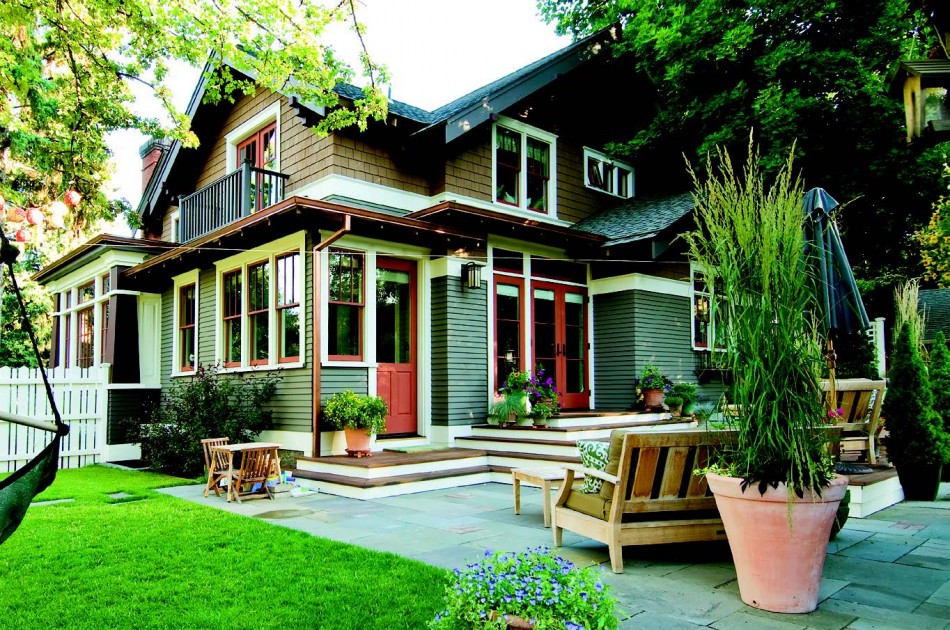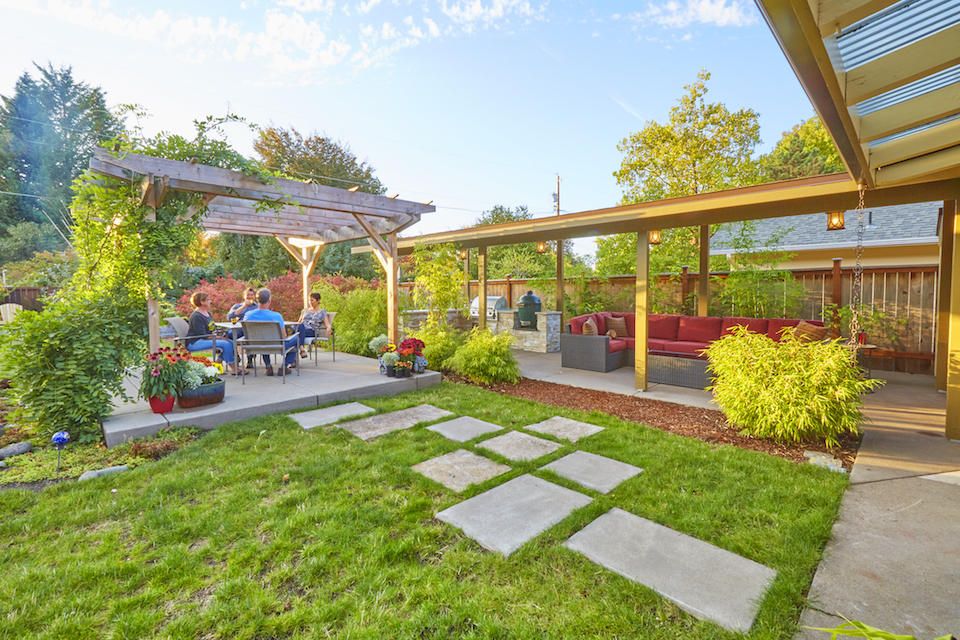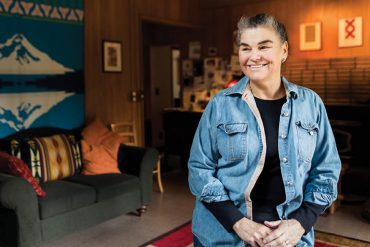Wendy and Doug Knight felt it was destiny when they happened upon a “for sale” sign thirty minutes after it was posted outside the home in Bend that they had been admiring for years. In 2003, they bought the classic American Craftsman, built in 1918 and listed on the National Register of Historic Places.
They were in love with the house and its location in the Drake Park Historic District, but certain elements neither fit their style nor suited their family, which includes daughters, Lindsay, 10, and Piper, 8. The interior was dark. The kitchen window looked directly into a neighbor’s window a few yards away. The master bedroom had little room for anything besides the bed. An enclosed back porch added in 1935 housed a washer and dryer and impeded access to the backyard. The kitchen space was tight, without room for a table.
They embarked on a mission to bring in more natural light and expand the home while restoring and preserving its architectural and historic integrity. The Knights added roughly 1,500 square feet to the original 2,900-square-foot “bungaloid” (a bungalow that is taller than one story), says Doug Knight, who owns a historic restoration and preservation business and is vice-chair of the Deschutes County Landmarks Association.
“The idea was to be respectful of the architectural style of the era and to do something fresh—filled with life and more southern exposure,” he says. The Knights removed the original kitchen and created a powder room, hallway, walk-in pantry and butler’s pantry. They sought the help of interior architect and designer, Kirsti Wolfe Designs, for their new kitchen.
Throughout the process, Wendy, also an interior designer, sought to add fresh and contemporary elements. “I tried to keep it from looking strictly ‘historic’ and heavy, and make it fun and liveable with some modern décor,” she says. For example, when Knight designed a vanity for the powder room, Wendy asked him to make it more surprising. He redesigned it with a more contemporary shape.
For the home’s three-and-a-half bathrooms, Wendy selected mosaic tile from Portland-based Pratt & Larson. Several of the floors included a floral pattern that carried through the theme of copper accents in the roof.
They replaced the enclosed back porch with an addition that included a 400-square-foot kitchen and casual dining area. The leaded window that once looked out from the dining area to the backyard, is now showcased there. It is flanked by glass-front cabinets that Knight designed with faux corbels to add an antique flair.
An island contributes additional workspace, including a retractable marble slab for rolling pastry and is also perfect for serving cheese and hors d’oeuvres. Transom windows and French doors provide passage to a sun-drenched deck, and the southern exposure fills this family area with light.
Alongside the kitchen dining area, the Knights added a mudroom, “the Central Oregon workhorse,” Knight says. It is designed to look as if it had been an enclosed porch. Deep drawers under the south-facing window seats offer storage, and cabinets painted with chalkboard paint itemize each family member’s favorite hobbies and drawings.
Also part of that addition is a solarium, with leaded windows that emulate the original ones throughout the home. In creating pocket doors, Knight hand-picked wood that matched the marbled grain of the original Douglas fir on trim throughout the home. He removed river rock that had been applied to the original mantle and restored it with period-correct pilasters and finials.
The stairwell leading to the second floor was a dark tunnel, so the Knights expanded it and added a chandelier. In the master bedroom on the second floor, they added a Juliet balcony with a view of the Cascades.
“You’ve got to keep the romance alive in every detail,” says Wendy.
The master bath has Calcutta marble and a fiberglass tub that has the appearance of an antique. The real article, an original enameled, cast iron claw-foot tub, is in a second bathroom upstairs.
In the basement, the Knights created a circular floor plan with a playroom and adjoining office area for Wendy. A guest room with spa bath has calming and cool blue-green glass tile and a deep walk-in shower. A brick chimney converted into a laundry chute deposits dirty clothes dropped from a cabinet all the way up on the second story.
The Knights say their complementary talents helped make the project successful. “I do the architectural details and she does the colors and interior design,” says Knight. “Our forte is that we work as a team—I love working with her, and we have a lot of mutual respect.”
When Home Is a 103-Year-Old Hotel
Samantha Irwin was a little girl when she and her father peered through the window of the Balch Hotel in Dufur about thirty years ago. She was entranced by the beauty of the 1907 building—particularly the original, L-shaped hotel desk. The hotel was built by Charles P. Balch, a local rancher and druggist who made the bricks on his ranch.
Irwin hadn’t thought much about the hotel again until 2006. “After having taught middle school for thirteen years, I was trying to figure out what was the next thing I was supposed to do,” says Irwin, 40. Because she is skilled at organizing events and loves the labor of landscaping, she had been looking for a venue where she could combine those passions and host weddings. Her brother saw an ad for the hotel, and when she returned, this time with her husband, Jeff Irwin, she fell in love with it all over again.
“I’m a risk-taker, the visionary, the wild card,” Irwin says. “I tend to bite off more than I can chew. Jeff’s the balance—a steady Eddy, and you need that good balance to be successful.” The previous owners had done a major restoration, but some repairs and landscaping remained.
Not only were they restoring a hotel, they were creating a home. At first, they took a bedroom with a private bath as their own. When they realized that most guests prefer a private bath, they decided to move into two guest rooms and take as their own the former shared bath across the hall.
The doors, windows and woodwork in those rooms needed to be refinished, but that had to wait until after they finished first floor guest areas, which are also part of their home—a kitchen, lobby, parlor, dining area, two bathrooms and an office.
“We live in the whole hotel, we just share it with people who pay a fee,” Irwin says.
Much of the first floor rooms needed plaster repair. A young “hotshot” contractor told her that the original plaster looked bad and that he could make all of the walls smooth and perfect, she says.
“I had fallen in love with the original plaster that’s bumpy, has lines in it, with big globs and brush marks, and some places that are smooth,” Irwin recalls. “It adds texture and character. Now I had someone trying to tell me how bad it looked, and I couldn’t afford to redo the texture on the whole building. That was a defining moment of—I like this, and I like it for a reason. Be damned whoever doesn’t.”
She called a veteran—Tracy Wickwire of This Old Painter in Hood River. “He showed me how to match the plaster to the original, and said, ‘This is not difficult,’” Irwin remembers. “The more messy and the more free I was, the more it matched the original in the hotel. … I can’t make it smooth to save my life.”
Wickwire also showed her how to repair the original, hundred-year-old wood window trim and retain its distressed look. “He taught me the word ‘patina’ and gave me that validation that what I saw is really beautiful,” she says. “It may be less expensive to replace the trim with new wood than to strip and refinish it, but you’d be losing history.”
On any given day, Irwin switches between being a charming hotelier, and doing the landscaping and restoration work. She’ll greet a guest, then kick off her heels, don her father’s old overalls, put on a hat and get to it before returning to the hotel’s 103-year-old reception desk that she first saw as a child.
Rescuing a Queen Anne from the Brink
In 1980, Roy and Kim Fox had stood on the front porch of a Queen Anne Victorian farmhouse built in 1884, perusing the daunting list of code violations posted on the front door by the City of Portland, which had condemned it. But the Foxes had a vision that went beyond the tree seedlings that were sprouting from the roof. They could see the home’s enduring beauty, and they bought it.
“We sat on the stairway and said, ‘This is going to be really cool for Christmas,’” Roy recalls. For the next eighteen months, they worked on it every night after work doing roofing, painting, wiring, plumbing, repairing the foundation and installing a new kitchen and bathroom just so the city would let them move in, which they did just before Christmas Eve in 1981.
Since then, they have restored to nearly its original state the home’s three bedrooms, two-and-a-half baths, front and back parlor, dining room, entrance hall, kitchen and butler’s pantry. They enclosed the back porch and added a sunroom and laundry room. The original layout, doors, windows, floors, woodwork and other features are intact. The Foxes pored over documents more than a century old to rebuild the porch (the postman had refused to set foot on it), and they re-created an 1880s kitchen based on the original floor plan. In the basement, they built Roy’s shop, Kim’s office and a playroom for sons, Adam and Taylor, who were born during the renovation.
Nearly three decades later, one task remained: energy efficiency. The ambitious couple had improved the floors and added attic insulation, but heat leaked through the walls as if it had a hole that a truck could drive through, Roy says. “It was the last great frontier – how to make it more efficient without compromising the integrity of the home.”
Last year they saw that technology and incentives had improved enough to achieve that. At about the same time, the city launched Clean Energy Works of Portland, a loan program allowing residents to make energy efficiency upgrades with no up front costs. The Foxes seized the chance to have the entire house evaluated and tackle all the upgrades at once. They turned to Marshall Runkel of EcoTech in Portland.
Runkel says the challenge was to insulate the walls without damaging the siding. “There aren’t any real great rules about how to do that,” he says. “With houses dating back to the 1920s, it’s relatively easy to pry off a piece of siding, drill through sheeting in the walls to install insulation and reinstall the siding. You touch up the paint and nobody knows we were ever there. But with an extremely old house like the Fox’s, there was absolutely no way to get that wood siding off temporarily without it crumbling in your hands.”
So EcoTech modified its insulation blowing equipment, attaching a nozzle to a tube and extending it from the basement and into the walls up two stories and into the attic. They took advantage of the home’s balloon framing in some sections to insulate all the way through.
The $14,000 project, completed in June, also included insulating the roof, sealing air leaks and installing a smaller, more efficient furnace. It has kept their house cooler than they expected this summer, and the Foxes expect the energy savings eventually will offset the loan.
“We rescued a relatively early Portland home and made it significantly more efficient,” Roy says. “With the right owners, this house has another 125 years in it. Our two boys say they have no intention of ever selling this place. And, it still looks cool at Christmas.”









